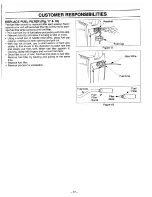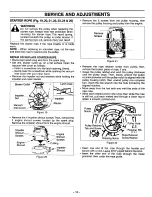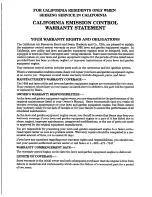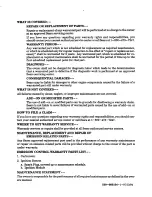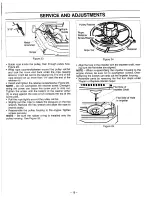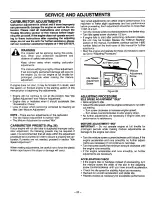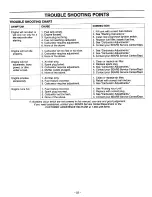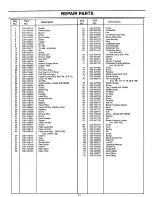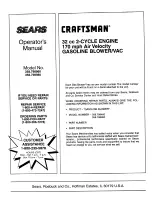
OPERATION
STOPPING YOUR ENGINE
• Move the ignition switch to the "Stop" position.
• If engine does not stop, move the choke lever to the "Full
Choke" position.
A
WARNING
When starting the engine, hold the unit as shown
in Figure 13. Do not set the unit on any surface
except a clean, hard area while the engine is run-
ning. Debris such as gravel, sand, dust, grass,
etc. could be picked up by the air intake and
thrown out through the discharge opening, dam-
aging the unit or property or causing serious
injury to bystanders or operator.
For safe starting and operation, follow all safety
precautions in this operator's manual and labels
on the unit. Dress properly before starting engine.
On mulch bladed units, blades are noisy during
start-up.
Avoid any contact with the muffler. A hot muffler
can cause serious burns.
BASIC STARTING PROCEDURE
(Fig. 13
&
14)
COLD ENGINE START AND WARM ENGINE
START AFTER RUNNING OUT OF FUEL
• Fuel engine with
40:1
fuel mix (3.2 oz. to
1
gallon gas).
Move
10
feet (3 meters) away from fueling site.
• Move ignition switch off of the "Stop" position.
• Activate throttle lock.
• Press primer bulb 6 times.
• Actuate choke by moving the choke lever to the "Full
Choke" position.
• Hold the unit in the starting position as shown. When
using the unit as a blower, make sure the blower end is
directed away from people, animals, glass, and solid
objects. When using the unit as a vacuum, make sure the
vacuum end is directed away from people, animals,
glass, and solid objects and that you support the vacuum
tube off the ground during starting.
• Pull starter rope sharply five times.
NOTE -
The engine may sound as if it is trying to start
before the 5th pull. If so, go to the next step immediately.
Blower
Starting
Position
Vacuum
Starting
Position
NOTE -
When pulling the starter rope, do not use the full
extent of the rope. Do not let the starter snap back. Hold
the handle and let the rope rewind slowly.
• Move the choke lever to the "Half Choke" position.
• Pull the starter rope sharply until the engine runs, but no
more than six pulls.
If the engine still has not started, it is probably flooded.
Flooded engines can be cleared of excess fuel with the
following procedure.
• Move the choke lever to the "Off" position.
• Press primer bulb 6 times.
• Squeeze and hold the throttle trigger.
• Pull starter rope to clear the engine of excess fuel.
Starting could require pulling the starter rope handle many
times depending on how badly the unit is flooded. If engine
still fails to start, refer to the "Trouble Shooting" chart.
Once the engine starts, allow the engine to run 15
seconds, then move the choke lever to "Off Choke". Allow
the engine to run for 30 more seconds at "Off Choke"
before releasing the throttle lock.
NOTE -
If the engine dies with choke lever at "Off Choke"
position, move the choke lever to "Half Choke". Pull starter
rope three times. Move choke lever to "Off Choke" position,
pull the rope until engine runs. Run engine 30 seconds with
throttle trigger fully squeezed.
• Release throttle lock by squeezing the trigger.
• To stop the engine, move the ignition switch to the "Stop"
position.
STARTING A WARM ENGINE
• Move the ignition switch off of the "Stop" position.
• Activate throttle lock.
• Press primer bulb 6 times.
• Move choke lever to the "Off Choke" position.
• Squeeze throttle trigger.
• Pull starter rope until engine starts.
• Release the throttle lock by squeezing the trigger.
Figure
14
DIFFICULT STARTING OR FLOODED ENGINE
The engine may be flooded with too much fuel if it has not
started after 20 pulls.
Flooded engines can be cleared of excess fuel with the
following procedure:
• Move ignition switch off of the "Stop" position.
• Activate the throttle lock.
• Move the choke lever to the "Off Choke" position.
• Squeeze and hold the throttle trigger.
• Pull starter rope handle until engine starts.
• Release the throttle lock by squeezing the trigger.
Starting could require pulling starter rope handle many
times depending on how badly unit is flooded. If engine still
fails to start, refer to ''TROUBLE SHOOTING" chart or call
the
1-800
number listed on the front cover of this manual.
-14 -

















